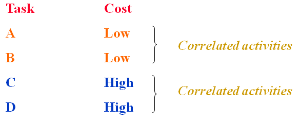Risk management - Correlated events
Correlated events
When looking at correlation you should not get this confused with task relationships in a project schedule, for example finish to finish and finish to start.
This is dealt with in much more detail elsewhere [see ‘The Complete Project Management package’] and [see 'The Complete Project Management plus PRINCE2'] in this series.
Tasks (activities) A, B, C, D etc may well be ‘linked’ in some fashion in the schedule, for example:
There may be a START to START (‘C’ cannot begin without ‘B’ starting) or a FINISH to START relationship (‘C’ cannot begin without ‘B’ finishing).
Remember, this is not the same as correlation.
Correlation is the relationship between the activities that are driven by a common underlying uncertainty. If one is HIGH others in the group will be HIGH, if MEDIUM the others will be MEDIUM and when LOW the others will be LOW.
These correlations could have a large affect on the whole project and can easily be ignored.
In a similar fashion to the use of PDFs, if we analyse data from a lot of activities we can assess if there is a correlation between the data and the degree of correlation (correlation factor).
For risk assessment purposes, if we decide that there is a correlation between different activities we can suggest a correlation factor. Then using the PDF model generate random samples.



